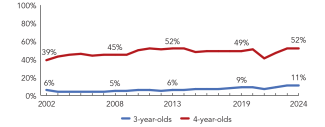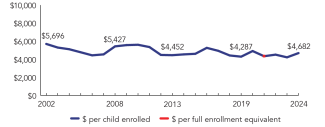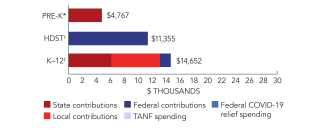
State of Preschool
Texas
Access Rankings
Resource Rankings
Total Benchmarks Met
Overview

During the 2023-2024 school year, Texas preschool enrolled 248,371 children, an increase of 4,779 children from the prior year. State spending totaled $1,059,019,621 and an additional $2,400,000 in federal recovery funds supported the program, up $125,267,307 (13%), adjusted for inflation, since last year. State spending per child (including federal recovery funds) equaled $4,682 in 2023-2024, up $468 from 2022- 2023, adjusted for inflation. Texas met 2 of 10 quality standards benchmarks.
What's New

The Texas Legislature passed House Bill 2729 in 2023, to establish that public prekindergarten teachers in nonpublic settings must have one of six qualifications and be supervised by a certified teacher who meets the criteria to teach eligible 4-year-old children in a public school setting. These additional qualifications are detailed in Texas Education Code 29.167. Previously, all prekindergarten teachers serving eligible PreK4 children were required to be certified and meet an additional qualification. Under the new requirements, lead teachers in nonpublic schools are no longer required to have a BA or P-6 certification.
Background
In 1985, Texas began funding half-day prekindergarten for eligible 4-year-olds through the Texas Public School Prekindergarten program. Currently, school districts with 15 or more eligible 4-year-olds are required to offer prekindergarten. Districts with 15 or more eligible 3-year-olds can also offer prekindergarten but are not required to do so. The Texas Education Agency (TEA) Early Childhood Education Division oversees prekindergarten programs in school districts and open-enrollment charter schools, and school districts that are permitted to subcontract with nonpublic preschools to serve eligible children.
Children are eligible to participate in a Texas public school prekindergarten program if they are age-eligible and meet at least one of the following conditions: qualify for free or reduced-price lunch (185% FPL), are homeless, are in foster care, have a parent on active military duty or who was injured or killed on active duty, are unable to speak or comprehend English, and/or have a parent eligible for the Star of Texas Award.
In 2019, the Texas PDG B–5 team and Texas Early Learning Council led the use of grant funding to conduct a statewide 0-5 needs assessment, develop a statewide 0-5 strategic plan, increase parental choice and knowledge, share best practices, and improve overall quality of care. Also in 2019, House Bill 3 was passed by the 86th Texas Legislature and signed into law by Governor Abbott. House Bill 3 added an early education allotment that school districts and charter schools can use to fund full-day high-quality prekindergarten for eligible 4-year-olds, expanded early education reporting, updated requirements for early learning progress monitoring tools (single kindergarten assessment with one alternative available), and updated requirements related to early childhood partnerships.
The Children’s Learning Institute at the University of Texas-Health Science Center at Houston, in partnership with the TEA and Texas Workforce Commission, has developed a comprehensive professional development platform for early childhood educators that is free to all public school teachers, Head Start programs, families, and child care providers.
Texas Public School Prekindergarten
Access
Resources
| Total state pre-K spending | $1,061,419,621 |
| Local match required? | No |
| State Head Start spending | $0 |
| State spending per child enrolled | $4,682 |
| All reported spending per child enrolled* | $4,767 |

*Pre-K programs may receive additional funds from federal or local sources that are not included in this figure. †Head Start per-child spending includes funding only for 3- and 4-year-olds. ‡K–12 expenditures include capital spending as well as current operating expenditures.
Texas Quality Standards Checklist
| Policy | Requirement | Benchmark | Meets Benchmark? |
|---|---|---|---|
For more information about the benchmarks, see the Executive Summary and the Roadmap to State pages. | 2benchmarks met | ||
| Early Learning & Development Standards Benchmark | Comprehensive, aligned, supported, culturally sensitive | Comprehensive, aligned, supported, culturally sensitive | |
| Curriculum Supports Benchmark | Approval process | Approval process & supports | |
| Teacher Degree Benchmark | BA (public); Other (nonpublic) | BA | |
| Teacher Specialized Training Benchmark | P-6 (public); Other (nonpublic) | Specializing in pre-K | |
| Assistant Teacher Degree Benchmark | HSD | CDA or equivalent | |
| Staff Professional Development Benchmark | 30 hours/year (teachers only) | For teachers & assistants: At least 15 hours/year; individual PD plans; coaching | |
| Maximum Class Size Benchmark | 22 (3-&4-year olds) | 20 or lower | |
| Staff to Child Ratio Benchmark | No limit (3-year-olds); Must strive for 1:11 (4-year-olds) | 1:10 or better | |
| Screening & Referral Benchmark | Vision, hearing, immunizations | Vision, hearing & health screenings; & referral | |
| Continuous Quality Improvement System Benchmark | None | Structured classroom observations; data used for program improvement | |
